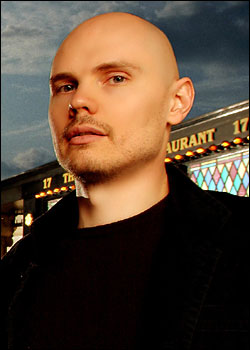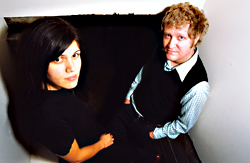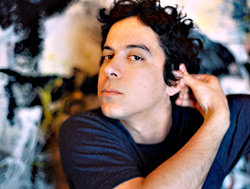Maybe GRUNGE really is back. Or perhaps it just stepped outside for a smoke. For five years. And found its way back into the building again through a side door after bribing the security guard with a 20-spot.
Whatever the back story, after listening to former Smashing Pumpkins svengali Billy Corgan’s latest project, Zwan, one can be forgiven for thinking that the Grunge Years never really ended in the first place. That distinctive Queen-meets-Black- Sabbath mash-up pioneered by the Pumpkins and Mother Love Bone well over a decade ago is splattered liberally about the group’s debut disc like an errant can of Day-Glo paint, elevating otherwise straightforward pop compositions like the album’s first single, “Honestly,” straight into the heavens. Which, as it turns out, has been the Tall Uncool One’s desired destination all along.
I don’t know quite how to venture this opinion without sounding either corny or overly dramatic, but let’s try it on for size anyway: After a lengthy, frustrating search, Billy Corgan has finally found God. And in so doing, has seemingly liberated himself from the demons that plagued the Pumpkins throughout much of that band’s star-crossed career.
That said, Zwan’s Mary Star of the Sea (Martha’s Music/Reprise) is not exactly Corgan’s Saved. Nor is it his Human Clay. In fact, it’s a mistake to even call this “Billy’s latest project.” Zwan are way, way more than that (we’ll return to this theme a bit later).
This God stuff is no trifling thing. You’ll recall that Corgan is a guy who subtitled one of his albums The Machines of God. Who once tossed off lyrics like “Emptiness is loneliness/And loneliness is cleanliness/ And cleanliness is godliness/And God is empty, just like me.” Who conceived a song about unbearable loneliness (“Soma”) that closed with a sampled snippet of a TV evangelist wailing to an unseen audience, “You need to resist the devil so that he will flee!” And whose personal God complex ran deep enough that, when his band was shattering its Fleetwood Mac-like romantic entanglements and generally going to pieces all around him (during the messy recording of the Pumpkins’ epic Siamese Dream), he simply picked up every damned instrument in sight and recorded the whole thing himself, like another God-channeling Midwestern musical genius before him, Prince Rogers Nelson.
Cherub Rock, indeedhis critics be damned, Corgan aspired to heights where angels feared to tread and occasionally emerged from the experience adored but with little except singed wings and a pained countenance to show for his troubles. His band’s unique blend of overwhelming neo-psychedelic woo and intimate, “secret-in-your-ear” confession struck a chord with millions of listeners during its heyday, taking the Pumpkins to the headline slot on Lollapalooza’s main stage, ringing up a furious din at the cash register, and making them the unlikeliest rock ‘n’ roll heroes since KISS first applied clown makeup. By taking the postmodern inventions of bands like My Bloody Valentine (who, through mutual producer Alan Moulder, had previously pioneered that nifty “loud/soft/loud” thing and colored their records with enough varying guitar voices to populate a cartoon seriesthe ever-astute Corgan promptly removed this page from the playbook and proceeded to fly about eight miles higher with it) and orchestrating a shotgun marriage with the classic rock moves and unapologetic ambitions of ’70s FM radio acts such as Queen and Boston, Corgan somehow found a way to keep a foot in both the goth-kid camp as well as the Camaro faction of the high-school parking lot.
THE APEXand in many ways, endgameof this vision was Corgan’s very own “Bohemian Rhapsody,” the double-disc prog-rock orgy of the senses Mellon Collie and the Infinite Sadness, a 28-song, two-hour-plus No. 1 album that spawned hit singles (“1979,” “Tonight, Tonight,” and the snarling “Bullet With Butterfly Wings”) and fiercely executed angst- metal telegrams (“Zero,” “Jellybelly,” “XYU”) in nearly equal proportions. The album was the Pumpkins’ tour de force, a preposterously outsized statement as different in scope and magnitude from its peers as Dostoevsky is to Doonesbury, and set a standard for quality and sheer ambition that the band could never again live up to. While on the road supporting the album, touring keyboardist Jonathan Melvoin (brother of Wendy Melvoin, Prince’s Revolution-era guitarist) died from a heroin overdose, an unhappy incident that also led to drummer Jimmy Chamberlin’s dismissal. The band released two more full-lengths that never again captured their full potential and sold in persistently smaller quantities; original bassist D’arcy Wretzky eventually departed (to be replaced by Hole bassist Melissa Auf der Maur); and increasingly the Pumpkins exuded the aura of a ship with the wind sucked suddenly from its sails, adrift and seeking landfall.
So when the Pumpkins finally called it a day with a Last Waltz-style four-hour send-off at Chicago’s Metro in 2000 (the same venue where the band had played one of its first gigs, opening for Jane’s Addiction 12 years earlier), no one who followed them closely could claim to be surprisedthey had flown a little too close to the sun and were now paying the price for their perceived arrogance. For all of Corgan’s years vision questing in an art form not known for its spiritual accommodation, he was left unfulfilled on some basic level and chose to walk away before his band became the alt-rock equivalent of hometown hero Michael Jordan, returning to a sport that needed him far less than he ultimately needed it.
WITH THE PRESSURE of leading a band hoisted from his shoulders, what’s a post-Pumpkin to do in his premature retirement? After trying his luck as a low-profile hired hand (to the extent that a 6-foot-4-inch bald man playing guitar in a revitalized New Order can credibly be called “low profile”), Corgan has returned to what he does best: putting on his God costume and assuming the (sacred) position.
To wit, here’s a representative sampling of where Billy’s coming from lyrically on Mary Star of the Sea:
“Here comes my faith to carry me on.” (The first line of the album’s opening track, “Lyric.”)
“I declare myself of faith.” (“Declarations of Faith”)
“We were meant to be just right/ Heaven sent, not sympathized.” (“El Sol”)
“A white horse picks my dreams up, to take my hopes to God/My prayers have nestled brightly to dim my sense of awe.” (“Ride a Black Swan”)
“Northern star, please enlighten the lost prayers of my soul.” (“Desire”)
There’s even a shred-happy recasting of the 1824 traditional hymn “Jesus, I My Cross Have Taken” (which features the closing line, “God and heaven are all my own”). And among the band’s dozens of other unreleased tracksone Web site lists nearly 80 total cuts that Zwan have recorded to dateone of those currently collecting dust in the vaults is titled “God’s Gonna Set This World on Fire.”
Not a bad turn of events for a guy who once famously sang, “Despite all my rage, I am still just a rat in a cage.”
In short, Zwan are the vehicle where Corgan’s rather Catholic tastes and yearning for a Grander Meaning to It All have come home to roost. It’s not entirely accidental that he lists himself on the record’s credits as “Billy Burke” (also the name of a Florida-based evangelical minister whose stated mission is to “touch the world with God’s healing power”)Corgan has emerged as a fully formed faith healer for the alt-rock masses, imparting fire-and-brimstone wisdom for the indie kids who were never particularly touched by Creed’s contrived casserole of grunge lite and McDonald’s drive-through Christianity.
Accompanying Corgan on his spiritual joyride is a veritable all-star lineup of alt-rock veterans: with David Pajo (Slint, Tortoise) on one guitar and Matt Sweeney (Chavez, Guided by Voices) on the other, Paz Lenchantin (A Perfect Circle) on bass, and former Pumpkins running mate Chamberlin on drums, Billy has finally assembled the three-guitar Skynyrd for the ’00s that his sonic vision essentially demanded. The Brian May guitar orchestras that once took Corgan month upon month of studio overdubs to achieve are now as easy as tuning up, plugging in, and letting his imagination wash over the proceedings like a cleansing flood sweeping the earth of its sin and plumage.
THE SAME TWIN urges that have always tugged at Corgan continue to form the tension at the core of his music, bringing the spirit of the underground (heard through Pajo’s Slint-like moments of stretched-out sonic sculpture, such as on the 14-minute-plus title track that forms the centerpiece of the album) aboveground (check out the Cheap Trick-like power pop of “Heartsong” or the Abbey Road guitar solo that neatly pirouettes through “Of a Broken Heart”). Zwan, like the Pumpkins before them, don’t always pull this maneuver off gracefully”Baby, Let’s Rock!” is only B-side fare, even by latter-day Pumpkins standards, while “Desire” is simply wasted spacebut when it happens, it’s bliss on the order of Corgan’s most wished-for fever dreams.
Whether you worshipped the Pumpkins or thought their music was the very nadir of the “accomplished” side of alternative rock, one aspect of the band that always merited respect was Corgan’s king-sized vision and his gift for the sonically paraspectacular. While Zwan are, in many ways, more of a collaborative effort than the Pumpkins could ever legitimately claim to be (a guiding principle that seems to have had the desired effect of recasting Corgan’s persona from pissant to prophet), Mary Star of the Sea is a logical, welcome extension of the Pumpkins’ musical legacy. Zwan form the basis of Corgan’s attempt to master the tricky art of speaking in tongues, to summon up a flawed, human spirituality that’s mostly missing in today’s superficial pop-life dialogue. And in my view, it can’t force Britney and her ilk off the radio fast enough.








